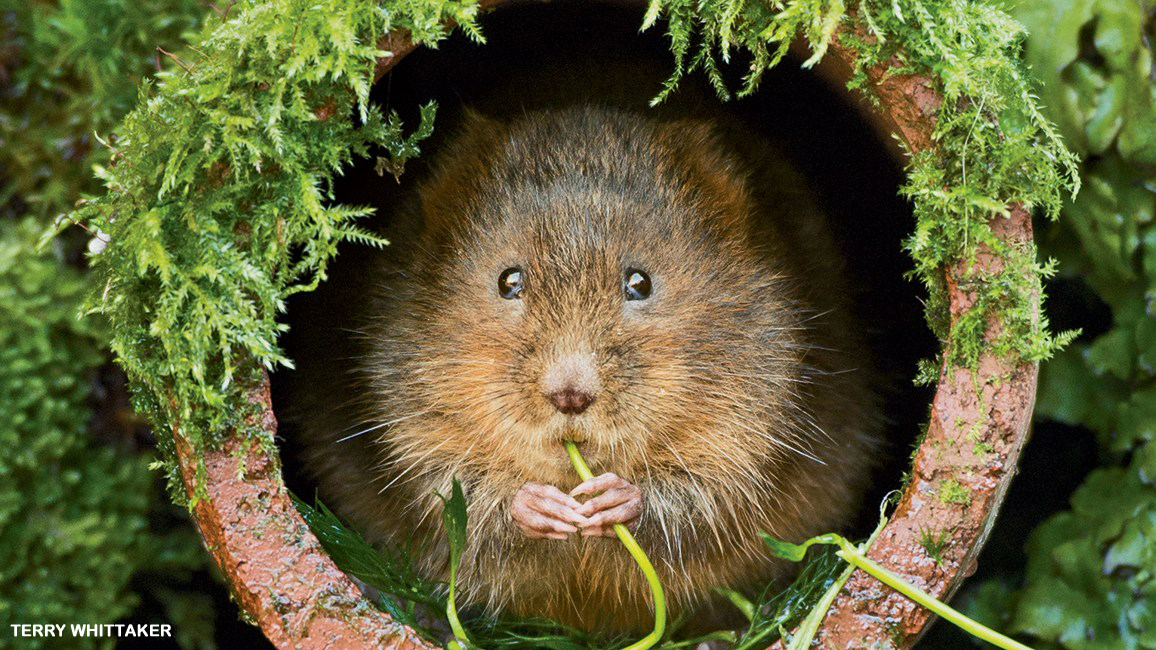
Welcome Back, Water Voles
By Kate Hofmann; Photos by Terry Whittaker; Art by Debbie PalenIn Great Britain, people are bringing water voles back to the wild. Read on for a tale with a happy ending!
My friends call me Ratty, but I’m really a water vole. You’ll find me in a tale called The Wind in the Willows.
The European water vole is a round, water-loving rodent that lives in most of Europe and parts of Asia (see map below right). In some places, there are so many that people find them bothersome. But in Great Britain, water voles are less common—and are well loved.
A water vole is one of the main characters in a storybook written over 100 years ago called The Wind in the Willows. The vole (known as the Water Rat, Rat, or Ratty) enjoys grand adventures with his friends Mole, Toad, and Badger. They boat on the river, picnic on the shore, and chat by the fireside in cozy burrows.
Real water voles don’t have boats or firesides, of course, but they do swim in streams, nibble plants along the banks, and live in burrows. The ones in Great Britain—where The Wind in the Willows takes place—were in danger of disappearing. But a big effort has brought them back.
VIDEO: WATCH A WATER VOLE IN ACTION!
Voles, Not Rats
Water voles are sometimes mistaken for rats and even called water rats. But they aren’t rats at all. Compared to a brown rat (which may live in the same habitat), a water vole has a more rounded nose, much smaller ears, and a shorter tail that’s furry, not bare like a rat’s. A water vole can be up to 12 inches long, including its tail—much larger than its North American cousin, the meadow vole!
Water voles eat plants—mostly grasses—and plant parts, such as berries, twigs, buds, and roots. (Scientists have identified more than 200 different kinds of plants in their diet.) Voles also sometimes eat insects.
Burrows in the Banks
Each water vole digs its own burrow in the bank of a stream or pond. The burrows have many levels and rooms, including places to store food for winter. Females also have nesting chambers where their babies are born. A water vole prefers a steep bank so it can make burrow entrances at different heights. Then, whether the water is high or low, the vole can swim right up to its front door. Water voles live near streams, rivers, ditches, ponds, lakes, and other wet places. This one is peeking out of a drainpipe. A water vole gnaws on plants for food and to make nesting material. Gnawing wears the teeth down quickly, but the teeth never stop growing. (That’s true of all rodents’ teeth).
Trouble for Water Voles
Water voles have always had lots of predators. Owls, herons, foxes, otters, pike (a big fish), and others will all make a meal of them. But bigger trouble came when minks arrived. People brought American minks (above) to Great Britain to raise them for their fur. Many escaped into the wild and spread. They were so good at hunting voles that the number of voles dropped fast. To make matters worse, important vole habitat disappeared when people drained waterways or built near them. And cows and other livestock trampled the banks and ate the plants that voles need for food and shelter (below).
Bringing Back Water Voles
Water voles used to be common all over Great Britain. But by the 1990s, they had disappeared from most of the places where they used to be. People began to wonder: Would Ratty live on only in the pages of a storybook? Or could people bring back real water voles?
Conservation groups around the region got to work on three big projects:
- Bring back vole habitat by replanting stream banks and keeping grazing animals away.
- Set traps to catch and remove the troublesome minks from places where water voles live.
- Raise water voles in captivity and release them back to the wild.
Ratty Returns
The Wildwood Trust in Kent, England, is one of the groups trying to bring back water voles. Baby voles are born there, and workers help them grow up to be healthy. Then they set the voles free, often doing something called a “soft release.” That’s when workers place special pens on stream banks and put the voles and some food inside. After the voles have a few days to get used to their new home, the people open small doors on the pens so the voles can leave whenever they are ready.
And the good news is, it’s working! Thanks to many groups joining the effort, water voles are making a comeback. The work isn’t done, but voles are once again swimming throughout Great Britain. Ratty would be proud!



















